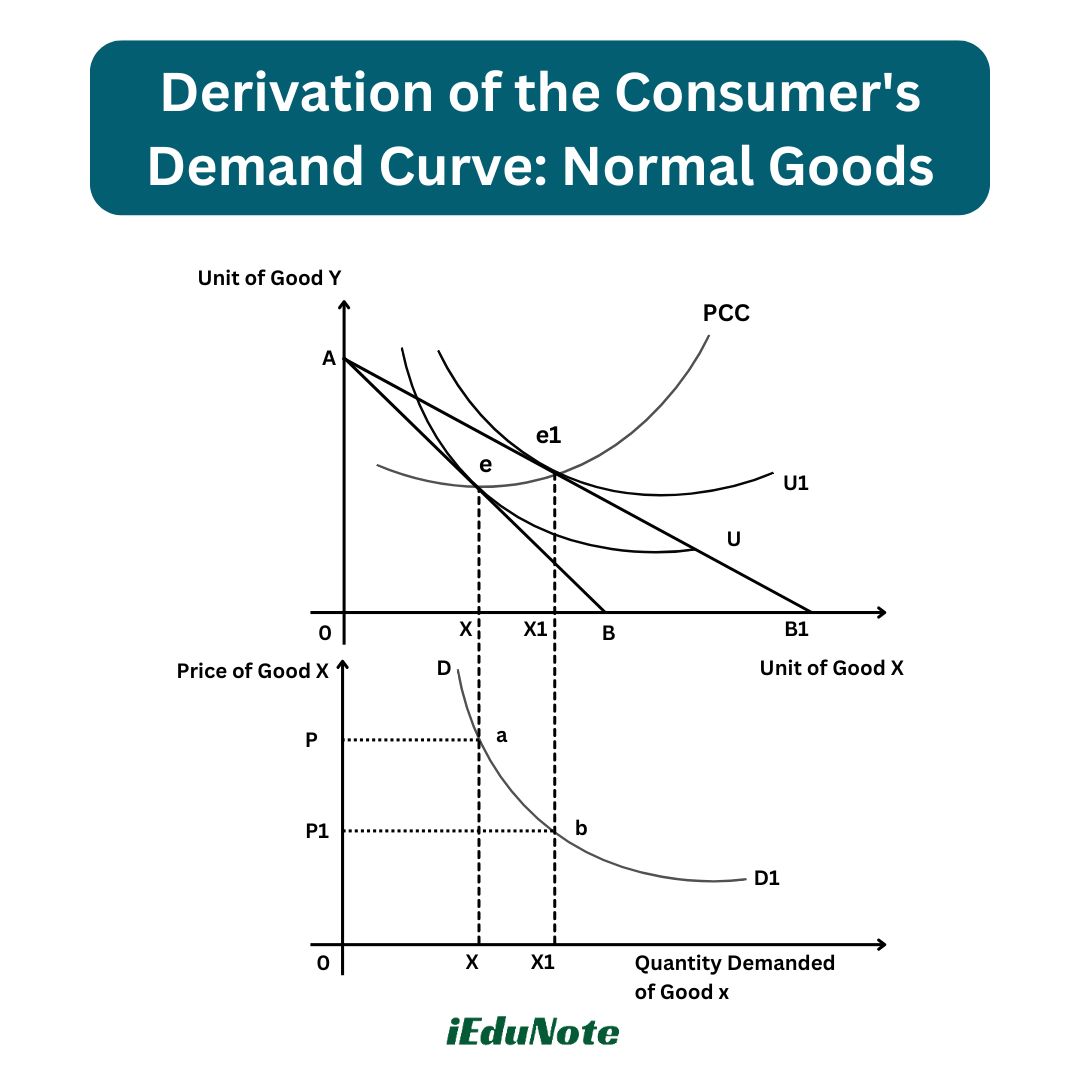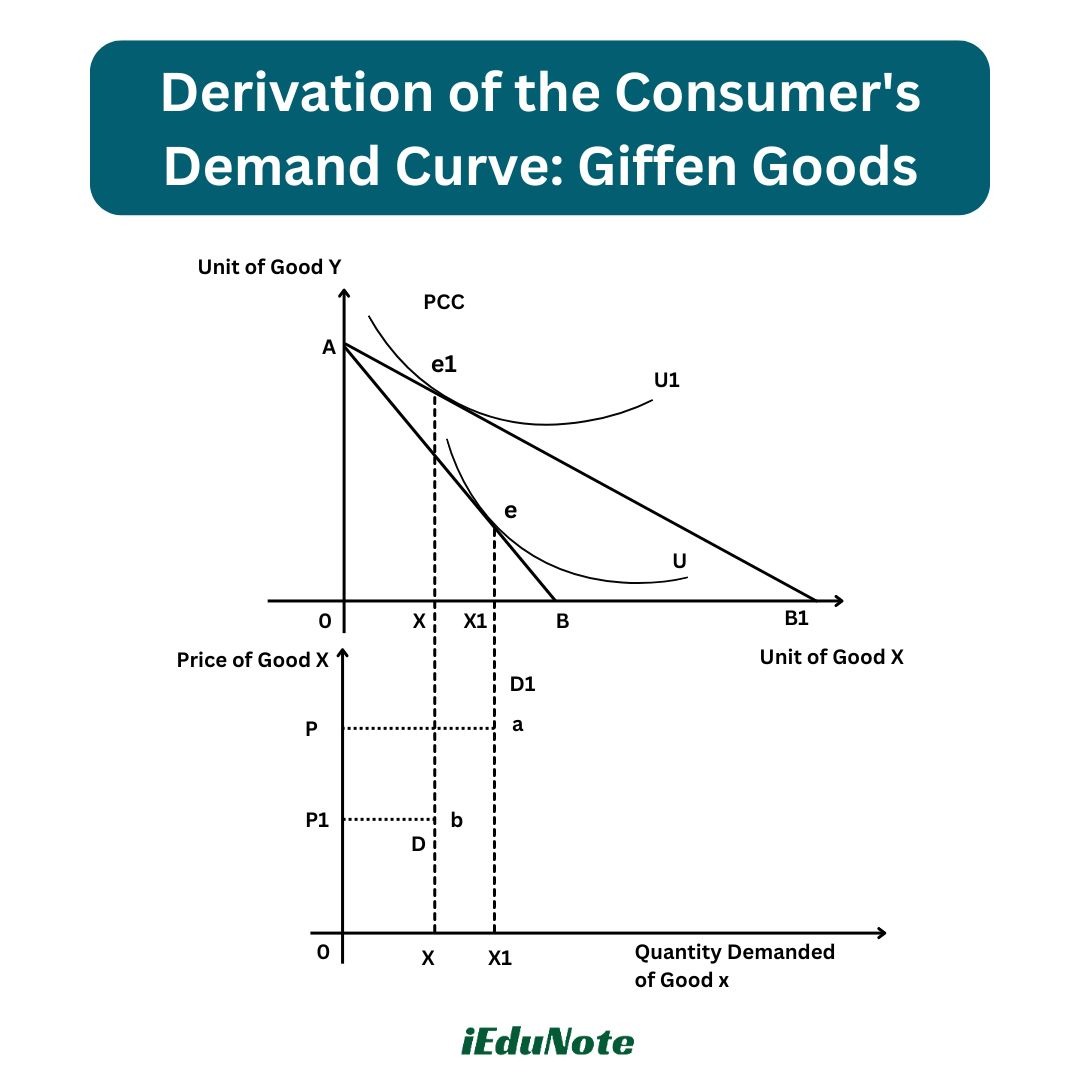Learn how the consumer demand curve for normal goods is derived from the price consumption curve, illustrating the inverse relationship between price and quantity demanded.
Derivation of the Consumer’s Demand Curve: Normal Goods
Normal goods will demonstrate a higher demand as a result of lower prices and vice versa. The demand curve shows the relationship between the price of a good and its quantity demanded.
In this section, we are going to derive the consumer demand curve from the price consumption curve.

The upper panel of the Figure shows the price effect where good X is a normal good. AB is the initial price line. Suppose the initial price of good X (Px) is OP.
e is the initial optimal consumption combination on the indifference curve U. The consumer buys OX units of good X.
When the price of X (Px) falls, to say OP1 the budget constraint shifts to AB1 The optimal consumption combination is e1 on the indifference curve U1.
The consumer now increases consumption of good X from OX to OX1 units. The Price Consumption Curve (PCC) is rising upwards.
The lower panel of the Figure shows this price and the corresponding quantity demanded of good X. At the initial price OP, the quantity demanded of good X is OX.
This is shown by point a. At a lower price OP1, quantity demanded increases to OX1. This is shown by point b. DD1 is the demand curve obtained by joining points a and b.
The demand curve is downward sloping showing an inverse relationship between price and quantity demanded as good X is a normal good.
Derivation of the Consumer’s Demand Curve: Giffen Goods
Giffen goods will demonstrate a higher demand as a result of higher prices Here we are going to derive the consumer’s demand curve from the price consumption curve in the case of inferior goods.
The upper panel of the Figure shows the price effect where good X is an inferior good. AB is the initial price line.
Suppose the initial price of good X (Px) is OP. e is the initial optimal consumption combination on indifference curve U. The consumer buys OX units of good X. When the price of X (Px) falls, to say OPi, the budget constraint shifts to AB1.
The optimal consumption combination is e1 on the indifference curve Up

The consumer now reduces the consumption of good X from OX to OX1 units as good x is inferior. The Price Consumption Curve (PCC) is rising upwards and bending backward towards the Y-axis.
The lower panel of the Figure shows this price and the corresponding quantity demanded of good X. At the initial price OP, the quantity demanded of good X is OX.
This is shown by point a. At a lower price, OP1 quantity demanded decreases to OX1. This is shown by point b. DD1 is the demand curve obtained by joining points a and b.
The demand curve is upward sloping showing a direct relationship between price and quantity demanded as good X is an inferior good.
Derivation of the Consumer’s Demand Curve: Neutral Goods
Neutral goods will demonstrate a neutral position or indifference to price in regard to the quantity demanded. Here we are going to derive the consumer’s demand curve from the price consumption curve in the case of neutral goods.

The upper panel of the Figure shows the price effect where good X is a neutral good. AB is the initial price line. Suppose the initial price of good X (Px) is OP.
e is the initial optimal consumption combination on indifference curve U. The consumer buys OX units of good X. When the price of X (Px) falls, to say OP), the budget constraint shifts to AB).
The optimal consumption combination is C) on indifference curve U1 at which the consumer buys the same OX units of good X as it is a neutral good. The Price Consumption Curve (PCC) is a vertical straight line.
The lower panel of the Figure shows this price and the corresponding quantity demanded of good X. At the initial price OP, the quantity demanded of good X is OX. This is shown by point a.
At a lower price OP), the quantity demanded remains fixed at OX. This is shown by point b. DD1 is the demand curve obtained by joining points a and b.
The demand curve is a vertical straight line showing that the consumption of good X is fixed as good X is a neutral good.